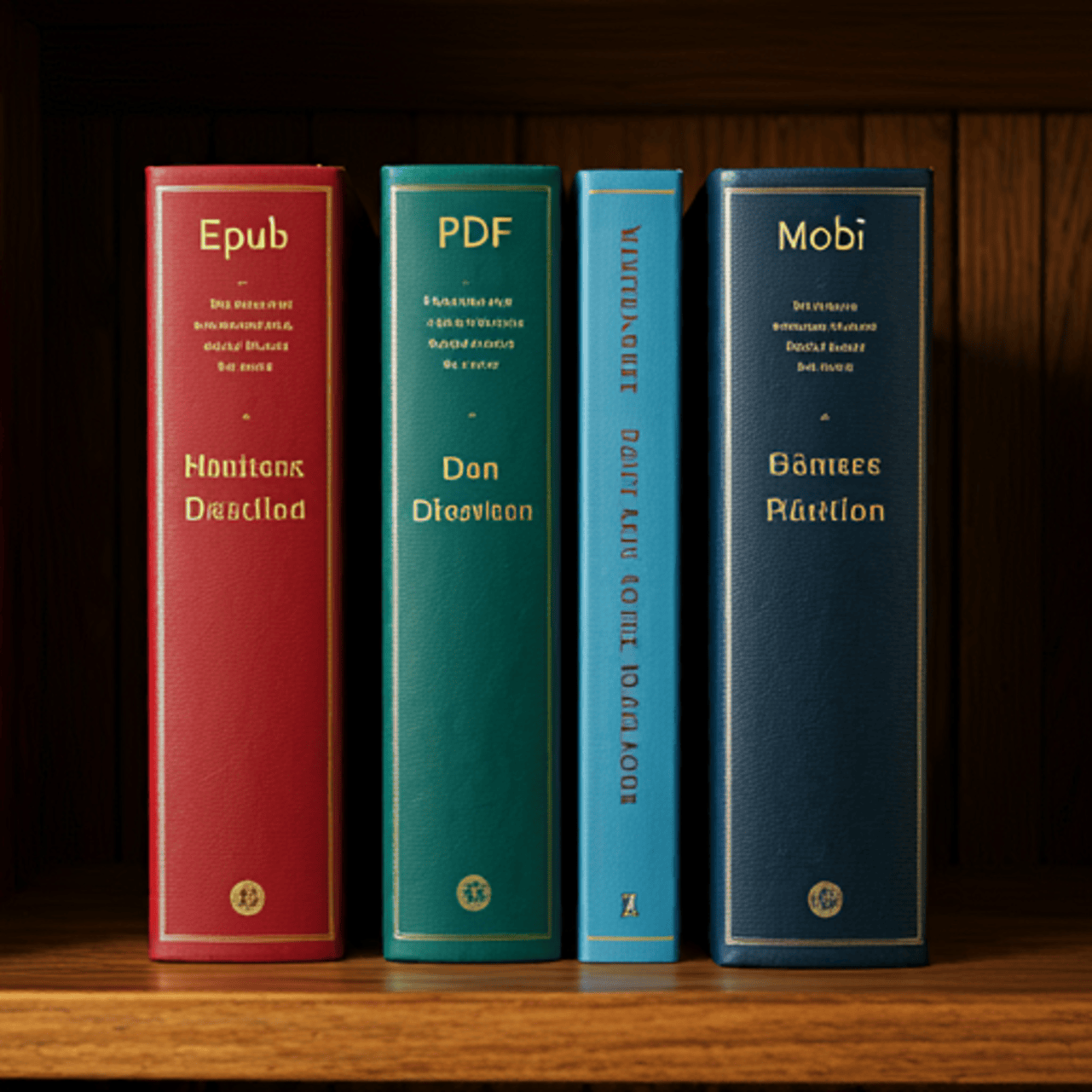Considering popular e-book formats for e-readers, the file extension and the format type are equally important factors. Common formats are EPUB, MOBI, and PDF. Popular e-book formats, such as EPUB, mean electronic publication and are extensively used as an adaptable format whose text flow fits different-sized screens.
MOBI was developed for the Kindle range of e-book readers from Amazon and comprised of various features such as bookmarks and the ability to make notes, but it does not have many functions when not used with Kindle. PDFs are popular for their ability to keep the formatting intact, which can be bubble, carpet, and rectangular, but that very layout sometimes renders the text illegible on discrete mobile devices. Each of those popular e-book formats has different strengths and weaknesses and knowing their file extensions will assist the users in determining the most suitable for their e-readers.
Table of Contents
*****Disclosure: This post may contain affiliate links, which means we may receive a commission, at no extra cost to you, if you make a purchase through a link.****
Compatibility with E-readers
Compatibility with e-readers is one more aspect which the users should keep in mind while deciding among the most common e-book formats. EPUB, one of the popular e-book formats, can easily be stated as the most widely accepted format among e-book devices such as Kobo and Nook. However, Amazon supports only the Kindle e-readers which use MOBI and its new spin-off AZW which most other devices do not allow. However, you can email EPUB’s to your device.
The PDF can be opened on any mobile device; however, it may be inconvenient owing to different characteristics of the screen size. And since popular formats for e-books usually include some embedded features, a reader has to check whether the specific format is supported by the e-reader to prevent any hassles. It is worth noting that before selecting a specific e-book format, the user will be guided to verify devices supported by the selected format.
File Size and Storage Requirements
Remember the other user comments and file size or storage requirements of people’s current popular e-book formats and more constraints regarding customization and other considerations such as portability as these might affect the user experience. EPUBs, among the popular e-book formats, for e-readers are usually less space-consuming than PDF files due to smaller file size.
Although usually, MOBIs would be bigger than EPUBS; they would be an effective format for compression but may expand due to some additional features. The size of a document also depends heavily on how many graphics or media are embedded in the document. There are more than a million choices of devices and applications out in the market but for readers who are acquiring and dealing with very thick virtual libraries, utilizing the most common e-book formats with minimal file size is most likely the approach for minimal space.
Readability Features
An important aspect of the e-book formats is the readability features. The reflowable text offered in EPUB enables the reader to change the size, type, and space of fonts enhancing the reading experience with more devices. Though MOBI files do not have much scope for customization, they do come with certain reading-enhancing elements like changing text or font sizes and changing the background color which increases reading comfort.
Out of all these magazine formats, PDF is the most reader-friendly one as it preserves all layout and typeface settings. The only drawback is that reading pdfs on very small screens can be impossible or unpleasant, because there is no reflow. While choosing one among the most commonly used e-book formats, ask yourself which one’s readability focuses will best serve you along with your device.
Supporting DRM
Another important point regarding popular e-book formats is the support for DRM or Digital Rights Management. Publishing consultants develop methods for controlling how e-books are distributed and used, and this, in turn, influences access to e-books. EPUB and MOBI, are popular e-book formats for e-readers, that are often used also enhanced with DRM, especially when used in such environments as the Amazon Kindle e-book store or other e-book shops.
At the same time, the availability of DRM usually restricts how users are allowed to share e-books across borders and platforms. PDF files also come with a DRM option, but such methods can be inconvenient. Why is this important when selecting one of the bestselling e-book formats? This is fundamental in trying to choose the right one so that the needs are satisfied.
Flexibility In Terms Of Switching The Used Formats
The issue of changing the formats of e-books into the commonly used ones is essential for many readers who possess different devices or use various services. The conversion of EPUB files, among the popular e-book formats for e-readers, to the desired formats such as MOBI or PDF files, turns out to be simple with the help of highlighting conversion tools.
The conversion of the files may either be successful without family matters encountered or may convert files such as MOBI to EPUB or PDF with some formatting subjects. These are less forgiving images or files that are converted into such and further into the other if so. This often requires a lot of time and often proper programs to do such conversion. When using several e-book formats, working with the conversion of these files, the readers will be able to organize their e-books across several devices and applications in a better manner.
Profiles and Style Considerations
Case formatting and style considerations are highly diverse in these widely used e-book formats because they affect how content is presented to end users through various devices. Popular e-book formats for e-readers, such as EPUB, are flexible and can change the format of the text according to the size and rotation of the screen. MOBI, on the other hand, contains inherent fixed layout capability but would still permit a certain degree of text alteration.
PDFs are essentially unbounded in their ability to alter layout however they tend to possess constraints on small displays due to the rigid properties of PDFs. When one is considering choosing one of the popularly used e-book formats, it is important to pay attention to the ease of use of formatting and layout options about your reading habits and devices as this plays a major role in determining how enjoyable the reading will be.
Interactivity and Support of Multimedia Content
It concerns reader enhancement and interactivity which is an essential characteristic of every popular e-book format. With the extreme flexibility of this format, many diverse interactive features can be incorporated, such as hot links, audio files, or even video support—enhanced e-books.
When looking for the information in MOBI files one can find some multimedia features but they are not as rich as those found in EPUB files. With multimedia inclusion, however, the interactive elements are many with the PDF file formats but the activity is primarily limited due to the nature of fixed layout. If you come to the consideration of popular e-book formats, think about how the format supports interactive features and multimedia as you will be looking more towards the consumption of the content rather than its creation.
Annotation and Highlighting Capabilities
Annotation and highlighting capabilities are primarily targeted towards high-engagement readers of any e-book. All the formats EPUB and MOBI tend to have features such as highlights, notes, and bookmarks that enable the user to actively become a part of the text and capture the text that they find important for other uses.
PDF files also allow annotation, although this might not be very handy, especially for smaller-sized devices where the screen may be too small to easily annotate using the software. The presence or absence of various annotation tools in the widely embraced e-book formats may determine how the readers interact with the reading materials and even where they cite the difference causes this to be an elemental factor when picking a format.
Text-to-Speech and Accessibility Features
Text-to-speech and accessibility features are essential to those e-readers who are unable to see as well as those who prefer to listen to the text, rather than read it. EPUB and MOBI formats can be easily used with the available text-to-speech programs making them less demanding to the users. However, due to the nature of the PDF file, such features may be less used due to the unchanging nature of pages as designed although some accessibility tools exist. When assessing how well popular e-book formats support text-to-speech, consider other accessibility features as well, to ensure any format you buy supports all readers, including the ones with disabilities.
Support for Metadata and Book Information About e-book formats being widely used, support for metadata and book information is another important aspect. The EPUB and MOBI formats have comprehensive support for metadata, granting users the ability to view such information as author name, publisher, date, and repertoire of works.
This metadata improves the classification and searchability of e-books in libraries and in devices. Metadata is also supported by pdf files but due to the confined structure of these files, it is not always easy to access such information and manage it. When choosing between popular e-book formats, think about how every particular format allows you to provide as much of the metadata and book information as possible for the ease of e-book organization and e-book search.
Cross-Platform Synchronization Cross-platform synchronization is significant for readers who utilize more than one device in accessing their e-books. It is common for books in EPUB and MOBI formats to allow as well cloud services for syncing progress, bookmarks, and even notes across different devices. This helps to ensure that, regardless of the device, the reading process will be uninterrupted.
Yet, PDF format although being technically versatile and compatible does not allow for such synchronization to the same extent. When picking any of the available and popular e-book formats, evaluation of how every combination allows for cross-platform synchronization is critical in sharing a consistent and uninterrupted reading experience.
Cost of Software and Tools
The cost of software and tools for managing common e-book formats can be very different. Many free and paid applications are available for reading and converting, and popular e-book formats such as EPUB and MOBI, can be well supported. Many free or paid PDF reading programs also exist, although there might be some complex features paid software only can offer. One more factor to consider while comparing the e-book formats is the cost of software and tools for the management and conversion of these files. This might further affect how much more one may be able to spend on the given popular e-book formats.
Popularity and Industry Adoption
The usability and support of some of the most popular e-book formats may be determined by their popularity and industry adoption. Among the formats of e-readers and platforms, popular e-book formats, such as the EPUB format, is the most widely used; thus, it is the most convenient one for most users. The use of MOBI standards is most common within the Kindle family of products.
Therefore, the only available devices and applications developed within the Amazon ecosystem are functional with this format. Since most PDF files are known to every person, more especially to students, this format is well accepted in all industries but has some drawbacks in e-book software. Among the most appropriate alternatives to popular e-book format systems understanding their industry acceptance and popularity can help with their compatibility with the planned materials.



